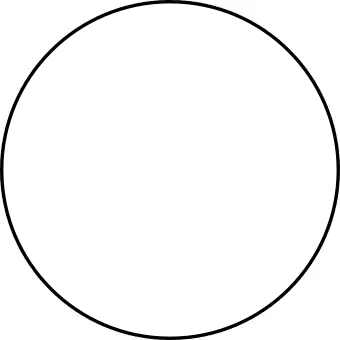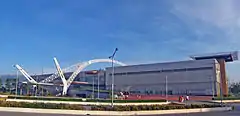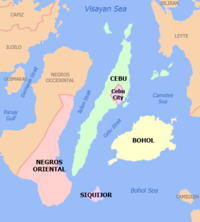Mandaue
Mandaue, officially the City of Mandaue (Cebuano: Dakbayan sa Mandaue; Tagalog: Lungsod ng Mandaue [mɐnˈdaʊ.ɛ]), is a 1st class highly urbanized city in the island province of Cebu in the region of Central Visayas, Philippines. According to the 2015 census, it has a population of 362,654 people. [3]
Mandaue | |
|---|---|
| City of Mandaue | |
 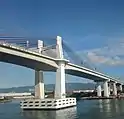 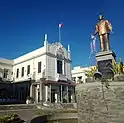 From top, left to right: Mandaue skyline viewed from the Mactan Channel, Marcelo Fernan Bridge, Sotero Cabahug monument beside the Mandaue Presidencia | |
 Seal | |
Nickname(s):
| |
| Anthem: Mandaue ang Dakbayan English: Mandaue, the City | |
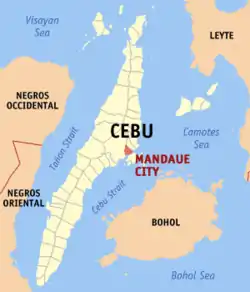 Map of Cebu with Mandaue highlighted | |
OpenStreetMap 
| |
.svg.png.webp) Mandaue Location within the Philippines | |
| Coordinates: 10°20′N 123°56′E | |
| Country | |
| Region | Central Visayas (Region VII) |
| Province | Cebu |
| District | 6th District |
| Founded | 12th–16th century |
| Municipality Status | 1901 |
| Cityhood | August 30, 1969 |
| Highly Urbanized City | February 15, 1991 |
| Barangays | 27 (see Barangays) |
| Government | |
| • Type | Sangguniang Panlungsod |
| • Mayor | Jonas C. Cortes |
| • Vice Mayor | Glenn O. Bercede |
| • Representative | Emmarie M. Ouano-Dizon |
| • Electorate | 226,091 voters (2019) |
| Area | |
| • Total | 34.87 km2 (13.46 sq mi) |
| Elevation | 122 m (400 ft) |
| Highest elevation | 100 m (300 ft) |
| Population | |
| • Total | 362,654 |
| • Density | 10,000/km2 (27,000/sq mi) |
| • Households | 98,907 |
| Economy | |
| • Income class | 1st city income class |
| • Poverty incidence | 11.34% (2015)[4] |
| • Revenue | ₱1,589,626,010.75 (2016) |
| Time zone | UTC+8 (PST) |
| ZIP code | 6014 |
| PSGC | |
| IDD : area code | +63 (0)32 |
| Climate type | tropical monsoon climate |
| Native languages | Cebuano Tagalog |
| Website | www |
Mandaue City is located on the central-eastern coastal region of Cebu. Its southwest coast borders Mactan Island where Lapu-Lapu City is located and is connected to the island via two bridges: the Mactan-Mandaue Bridge and Marcelo Fernan Bridge. Mandaue City is bounded on the north by the town of Consolacion, to the east by the Camotes Sea, and to the west and south by Cebu City.
It is one of three highly urbanized cities on Cebu island and forms a part of the Cebu Metropolitan area[5] and is part of the Sixth District Cebu joined with the municipalities of Consolacion and Cordova. Although qualified for a lone district since 1991, this was neglected by lawmakers. However, as of 5 April 2019, President Rodrigo Duterte recently signed a law declaring this city as a lone legislative district.[6]
History
A community was established in Mandaue by a flourishing group of Austronesian people. The Venetian chronicler Antonio Pigafetta wrote of a settlement called misspelled the place Mandani which existed in the area with a chieftain named Apanoaan[7] some called him Lambuzzan in other accounts.[8]
Mandaue natives were forced into a town as decreed by the Spanish authorities. This may have started off as a mission village (which included present day Consolacion, Liloan and Poro) serving as a bulwark for the church in the northern Cebu and was managed by the Jesuit in 1638 then a century later by the Recollects.[9]
The Philippine revolution in 1898 gave the town a new form of administration in accordance with the organic decree of the Central Revolutionary Government. The short-lived revolution was overthrown by the American Troops and a battle nearly destroyed the town in 1901, killing Presidente Benito Ceniza.[10]
Mandaue was a semi-autonomous functioning town. Semi-autonomous as it was still under the jurisdiction of Cebu. Despite having been developed and organized by the Spaniards through-out the ages and its population increasing as the years gone by, the Spaniards did not make an initiative to elevate the town into an independent municipality. It was only after the death of Presidente Ceniza and the establishment of American Rule in Mandaue that the dream of becoming an independent municipality came true. In 1901, Mandaue became an independent municipality.[11]
Mandaue became independent from being an American Commonwealth and a Japanese garrison on July 4, 1946 along with the entire nation. Mandaue became a chartered city on August 30, 1969 and decades later it was recognized as an HUC (Highly Urbanized City) on February 15, 1991.[12] In early-April 2019, Duterte signed a law that declared Mandaue City as a lone legislative district, which means that it will be separated from the sixth district, and will have its own representative of the lone district.[13][14]
Geography
The city has a total area of 34.87 km2 (13.46 sq mi). According to the 2015 census, the population density is 10,000/km2 (26,000/sq mi).
|
|||||||||||||||||||||||||||||||||||||||||
The city is the 6th smallest government unit in terms of land area; among the Metro Cebu local government units the city is the second smallest next to the municipality of Cordova in the island of Mactan. The city's land area is only 4.5% of the total land area of Metro Cebu and less than 1% of the total land of the province of Cebu.
The North Reclamation Project, now known as the North Special Administrative Zone, currently has about 180 ha (440 acres) reclaimed land. Of the 180 hectares, about 36 ha (89 acres) belong to the city.
It is one of the two (the other one being the municipality of Consolacion) local government units located within the mainland Metro Cebu where the elevation of land is less than 100 m (330 ft).
Many of the areas of the city are extremely flat. About 77.37% is within the 0-8% slope category. Barangays belonging to this region are Centro, Looc, South Special Administrative Zone, Cambaro, Opao, Umapad, Paknaan, Alang-alang, Tipolo, Ibabao, Guizo, Subangdaku, Mantuyong, Maguikay and Tabok. The greater portion of the city, comprising about 70%, is dominated by the Mandaue Clay Loam soil series. This is found in the 0-2% and 2-5% slope ranges. Faraon clay loam characterizes the rest of the land with slope range from 5-8% and up to 25-40%.[15]
Climate
| Climate data for Mandaue City, Cebu | |||||||||||||
|---|---|---|---|---|---|---|---|---|---|---|---|---|---|
| Month | Jan | Feb | Mar | Apr | May | Jun | Jul | Aug | Sep | Oct | Nov | Dec | Year |
| Average high °C (°F) | 28 (82) |
29 (84) |
30 (86) |
31 (88) |
31 (88) |
30 (86) |
30 (86) |
30 (86) |
30 (86) |
29 (84) |
29 (84) |
28 (82) |
30 (85) |
| Average low °C (°F) | 23 (73) |
23 (73) |
23 (73) |
24 (75) |
25 (77) |
25 (77) |
25 (77) |
25 (77) |
25 (77) |
25 (77) |
24 (75) |
23 (73) |
24 (75) |
| Average precipitation mm (inches) | 70 (2.8) |
49 (1.9) |
62 (2.4) |
78 (3.1) |
138 (5.4) |
201 (7.9) |
192 (7.6) |
185 (7.3) |
192 (7.6) |
205 (8.1) |
156 (6.1) |
111 (4.4) |
1,639 (64.6) |
| Average rainy days | 13.4 | 10.6 | 13.1 | 14.5 | 24.2 | 27.9 | 28.4 | 27.7 | 27.1 | 27.4 | 22.5 | 15.9 | 252.7 |
| Source: Meteoblue [16] | |||||||||||||
Barangays
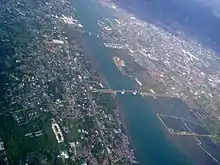
Mandaue comprises 27 barangays.
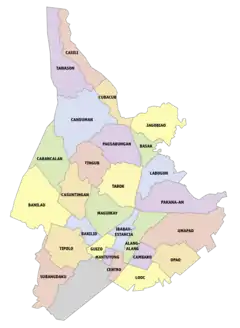
Bakilid (Est. 1928) Cambaro (Est. 1990) Casili (Est. 2006) Looc (Est. 1910) Tingub (Est. 1992)
| PSGC | Barangay | Population | ±% p.a. | |||
|---|---|---|---|---|---|---|
| 2015 [3] | 2010 [17] | |||||
| 072230001 | Alang-alang | 3.7% | 13,457 | 12,475 | 1.45% | |
| 072230002 | Bakilid | 1.3% | 4,591 | 5,027 | −1.71% | |
| 072230003 | Banilad | 6.3% | 22,771 | 22,297 | 0.40% | |
| 072230004 | Basak | 2.9% | 10,606 | 7,858 | 5.88% | |
| 072230005 | Cabancalan | 3.9% | 14,132 | 12,202 | 2.84% | |
| 072230006 | Cambaro | 2.6% | 9,474 | 8,082 | 3.07% | |
| 072230007 | Canduman | 5.2% | 18,852 | 17,100 | 1.87% | |
| 072230008 | Casili | 1.3% | 4,558 | 3,743 | 3.82% | |
| 072230009 | Casuntingan | 4.1% | 14,690 | 13,217 | 2.03% | |
| 072230010 | Centro (Poblacion) | 0.9% | 3,383 | 3,236 | 0.85% | |
| 072230011 | Cubacub | 2.8% | 10,284 | 8,255 | 4.27% | |
| 072230012 | Guizo | 2.7% | 9,623 | 8,554 | 2.27% | |
| 072230013 | Ibabao-Estancia | 2.6% | 9,503 | 8,641 | 1.83% | |
| 072230014 | Jagobiao | 3.8% | 13,685 | 12,227 | 2.17% | |
| 072230015 | Labogon | 5.8% | 21,028 | 19,175 | 1.77% | |
| 072230016 | Looc | 4.7% | 17,143 | 14,438 | 3.32% | |
| 072230017 | Maguikay | 4.0% | 14,645 | 17,782 | −3.63% | |
| 072230018 | Mantuyong | 1.8% | 6,540 | 5,869 | 2.08% | |
| 072230019 | Opao | 3.2% | 11,457 | 9,907 | 2.81% | |
| 072230020 | Paknaan | 7.4% | 26,943 | 22,957 | 3.10% | |
| 072230021 | Pagsabungan | 5.6% | 20,335 | 16,838 | 3.66% | |
| 072230022 | Subangdaku | 4.9% | 17,714 | 20,333 | −2.59% | |
| 072230023 | Tabok | 5.0% | 18,167 | 15,709 | 2.81% | |
| 072230024 | Tawason | 1.4% | 4,958 | 4,891 | 0.26% | |
| 072230025 | Tingub | 1.9% | 6,774 | 5,780 | 3.07% | |
| 072230026 | Tipolo | 5.2% | 18,840 | 17,273 | 1.67% | |
| 072230027 | Umapad | 5.1% | 18,501 | 17,454 | 1.12% | |
| Total | 362,654 | 44,732 | 48.95% | |||
Demographics
| Year | Pop. | ±% p.a. |
|---|---|---|
| 1903 | 11,078 | — |
| 1918 | 21,086 | +4.38% |
| 1939 | 17,431 | −0.90% |
| 1948 | 19,068 | +1.00% |
| 1960 | 29,281 | +3.64% |
| 1970 | 58,579 | +7.17% |
| 1975 | 75,904 | +5.33% |
| 1980 | 110,590 | +7.81% |
| 1990 | 174,342 | +4.66% |
| 1995 | 194,745 | +2.10% |
| 2000 | 259,728 | +6.37% |
| 2007 | 318,577 | +2.86% |
| 2010 | 331,320 | +1.44% |
| 2015 | 362,654 | +1.74% |
| Source: Philippine Statistics Authority [3] [17] [18][19] | ||
Data showed that the oldest written accounts of Mandaue came from a population of 160 in 1637 to 1638. Mandaue had 10,309 souls according to the Buzeta & Bravo (1850). During the first year of its township in 1899, Mandaue had 42 barrios with a population of 21,086. When Mandaue was a second class municipality in 1964 its population was 33,811.[20]
According to the 2015 census, it has a population of 362,654, which is an increase of 102,926. Mandaue has a significantly large population at or below the poverty line.[21]
Economy
About 40 percent of Cebu's export companies are found in Mandaue. The city is dubbed as the industrial hub of Region VII and hosts about 10,000 industrial and commercial businesses, making it a “little rich city” in the country. It is home to some of the world's biggest companies such as San Miguel Corp., Coca-Cola Bottling Corp. and Shemberg, the number one exporter of carrageenan. Mandaue City also accounts for 75 percent of the country's total exports in the furniture sector, making the city the furniture capital of the country.[22]
Tourism
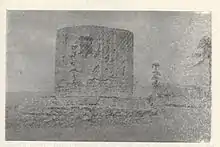
Mandaue's point of interests, destinations, and attractions include:
|
|
|
Fiestas
Mandaue Fiesta: Celebrated on May 8 in honor of the patron St. Joseph. Activities that are typically held during this feast are the inter-barangay sports competition, Miss Mandaue ( the longest-running beauty competition in the province), rodeos, street festival, bailes, fairs, and many more.
Panagtagbo sa Mandaue: This is Mandaue's current major festival in honor of the Holy Family. This is celebrated every 2nd week of January on the eve of theTraslacion (Transfer of Relic), of one of the significant religious events of the Sinulog Festival which commemorates the union of the Holy Family. In the Translacion, the Santo Niño and Birhen sa Guadelupe come and stay over at the shrine of Saint Joseph in Mandaue for an overnight vigil. This happens on a Friday, and on the early morning of the following Saturday, a fluvial procession is held on Cebu Strait going back to the Minor Basilica. In the festival, there are singing and dancing competitions with a street dancing during the Bibingkahan in honor of Santo Niño. At night, there is a ritual showdown performance which is the highlight of the cultural-religious events.
Kabayo Festival: The Kabayo (Horse) festival also known as Governor's Cup is a horse racing and different equestrian sports with the western way of riding event held annually in the second week of February.
Pasigarbo sa Sugbo: It is a festival showcasing Cebu's culture, faith, history, products, and festivals from each individual town. It is held annually around the 6th of August which is the Charter day of the Province of Cebu. It was formerly held in Mandaue City at the Cebu International Convention Center(CICC), but was transferred to the Cebu City Sports Complex in Cebu City in 2019 due to the abandoned and disrepaired state of the convention center.
Cuisine
.jpg.webp)
Mandaue has many restaurants which cater to gourmets and international cuisines like Italian, Japanese, Indian, Mediterranean, Lebanese, Arabic, Russian, Korean, Mexican, and Western cuisines. A variety of restaurants also serves meals of local cuisine.
Many famous Cebuano meals like the lechon[26] or inasal, eaten with achara or pickled vegetables. The sugba or barbecue of either isda (fish), baboy (pork), manok (chicken) or baka (beef) is found all over Mandaue eaten with puso, a diamond-shaped hanged rice covered in coco leaves. Kinilaw[27] is raw meat usually pork or fish drenched in vinegar and salt. The buwad or dried seafood, either fish or squid, can be pungent with a crunchy and chewy texture. There are some exotic meals that can be found like dinuguan or pig's blood which is eaten like a soup. Barbecued chicken feet are liked by many locals.
Original cuisine in Mandaue includes bibingka which is steamed rice cakes mixed with coconut and sometimes egg. Binangos paired with rice is made of ground up corn with Bolinao fish. This dish is found only in Mandaue; other delicacies includes the tagaktak, the seasonal buriring fish (stewed with iba) and the famous masareal.
Transportation
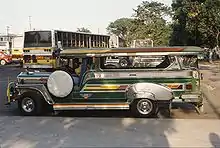
Mandaue City's road network is composed of a national highway which connects the city to its neighboring cities and municipalities, and a national secondary road which traverses the city's metropolitan area. The total length of the city road network (paved and unpaved) and the four bridges, is about 133.7 km (83.1 mi), broken down into:
- National road - 13.2 km (8.2 mi)
- City road - 57.1 km (35.5 mi)
- Barangay road - 63.4 km (39.4 mi)
Road density is 5.31 km/km2 (8.55 mi/sq mi) of land. In terms of population, road density is 0.04 km (0.025 mi) per one thousand inhabitants.
Land transportation is being served by PUJ, utility vehicles, mini-buses, multi-cabs, tricycles, trisikads and for cargoes, trailers and vans. Sea transport of Mandaue is highly dependent on Port of Cebu and Cebu International Port, because of the city's proximity to these facilities.
Education
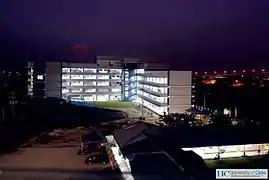
Mandaue houses two universities, the Cebu Doctors' University and the Lapu-Lapu–Mandaue campus of the University of Cebu. There are also technical schools like TESDA in barangays Banilad and Looc and other private institutions that provide certificate degrees. Associate degree, Baccalaureate Degrees, Master's and Doctoral programs.
Mandaue has institutionalized learning with the Cabahug Medal which was started on 1923 by Sotero Cabahug as a medal of academic excellence annually. The Mandaue Fraternal Society was also created in the early part of the 19th century to provide a community for the professionals during the time when Mandaue was still a sleepy town.
Cebu's part-time Japanese school, the Cebu Japanese School (CJS; セブ補習授業校 Sebu Hoshū Jugyō Kō), is located on the fifth floor of the Clotilde Commercial Center in Barangay Casuntingan, Mandaue City.[28]
Media
Television
Television stations based in Mandaue City:
- DYCB-TV (ABS-CBN Central Visayas) - Channel 3; a television station of the ABS-CBN's regional network division, ABS-CBN Regional, currently off-air due to the cease and desist order issued by the National Telecommunications Commission after its legislative franchise lapsed.[29]
- DYKC-TV (CNN Philippines) - Channel 9; a relay television station of the Radio Philippines Network / Nine Media Corporation.
Radio
Radio stations licensed in Mandaue City:
- DYKC-AM (Radyo Ronda) - 675 kHz; an AM station owned by the Radio Philippines Network / Nine Media Corporation, affiliate of CNN Philippines.
- DYAR-AM (Sonshine Radio) - 765 kHz; an AM station owned by Swara Sug Media Corporation and operated by Sonshine Media Network International.
- DYAB-AM (Radyo Patrol) 1512 kHz; an AM station owned by ABS-CBN Corporation, currently off-air due to the cease and desist order issued by the National Telecommunications Commission after its legislative franchise lapsed.
- DYPC-FM - 88.7 MHz; a community FM station owned by the Mandaue Broadcasting Center, an affiliate member of Vimcontu Broadcasting Corporation's radio station DYLA-AM in Cebu City.
- DYLS-FM (MOR Philippines) - 97.1 MHz; a commercial FM station owned by ABS-CBN Corporation, currently off-air due to the cease and desist order issued by the National Telecommunications Commission after its legislative franchise lapsed.
Sister cities
References
- City of Mandaue | (DILG)
- "Province: Cebu". PSGC Interactive. Quezon City, Philippines: Philippine Statistics Authority. Retrieved 12 November 2016.
- Census of Population (2015). "Region VII (Central Visayas)". Total Population by Province, City, Municipality and Barangay. PSA. Retrieved 20 June 2016.
- "PSA releases the 2015 Municipal and City Level Poverty Estimates". Quezon City, Philippines. Retrieved 12 October 2019.
- "The brilliance of Mandaue City". Mandaue City. cebu-philippines.net.
- https://newsinfo.inquirer.net/1115211/duterte-signs-law-creating-lone-legislative-district-of-mandaue-city
- To America and Around the World: The Logs of Christopher Columbus and of ... Antonio Pigafetta, Raleigh Ashlin Skelton. Branden Publishing Co. 2001. ISBN 9780828320634.
- Magellan's voyage: a narrative of the first circumnavigation. Antonio Pigafetta/ Adolph Caso. Yale University. 1994. ISBN 9780486280998.
- "Mandaue". admu.edu.ph. admu.edu.ph.
- Mojares 1999.
- https://www.mandauecity.gov.ph/
- "History". Mandaue City. Mandaue city government.
- https://newsinfo.inquirer.net/1115211/duterte-signs-law-creating-lone-legislative-district-of-mandaue-city
- https://www.manilatimes.net/duterte-signs-law-creating-lone-district-of-mandaue-city/551369/
- "Land Use". Mandaue City. Mandaue city government.
- "Mandaue: Average Temperatures and Rainfall". Meteoblue. Retrieved 10 May 2020.
- Census of Population and Housing (2010). "Region VII (Central Visayas)". Total Population by Province, City, Municipality and Barangay. NSO. Retrieved 29 June 2016.
- Censuses of Population (1903–2007). "Region VII (Central Visayas)". Table 1. Population Enumerated in Various Censuses by Province/Highly Urbanized City: 1903 to 2007. NSO.
- "Province of Cebu". Municipality Population Data. Local Water Utilities Administration Research Division. Retrieved 17 December 2016.
- "MANDAUE CITY: POPULATION TO REACH HALF A MILLION IN 2011". Census. Philippine Census.
- "Population". Mandaue City. Mandaue city government.
- http://www.unep.org/ietc/Portals/136/Other%20documents/Waste%20Management/Waste%20Plastic/WP_6_WasteQC_Mandaue.pdf
- Cebu Daily News 2015.
- "Other Landmarks". Tourism. The City of Mandaue. Archived from the original on 2008-03-14. Retrieved 2008-04-22.
- "Mandaue Opens First Agri Eco Park". Cebu Daily News. Philippine Daily Inquirer. Retrieved 2018-02-22.
- "lechon". lechoncebu.com.
- "Sugba Tuwa Kilaw". Travelocity.com. Travelocity.com.
- Home page. Cebu Japanese School. Retrieved on April 2, 2015. "5th /F Clotilde Commercial CenterM.L. Quezon St., Casuntingan, Mandaue City 6014 Philippines"
- "ABS-CBN goes off-air after NTC order". Rappler. 6 May 2020. Retrieved 5 May 2020.
- Tayona, Glenda; Silubrico, Ruby (25 August 2018). "Iloilo to showcase culture to 'sister cities' tonight". Panay News. Archived from the original on 9 April 2019. Retrieved 9 April 2019.
- "Mandaue City officials fly to Romania for sister-city deal". Manila Bulletin. Manila Bulletin Publishing Corporation. Retrieved 2012-06-22.
- "Mandaue, Mosul sign sister-city agreement". Official Website of Mandaue City. The City of Mandaue. Retrieved 2012-06-21.
Sources
- Buzeta, Fr Manuel & Bravo, Fr Felipe, eds. (1850). Diccionario, geografico, estadistico, historico de las Islas Filipinas (2 vols) (in Spanish). Madrid.
- Cebu Daily News, Norman V. Mendoza (23 January 2015). "Rainbow lane in Mandaue".
- Mojares, Resil B. (1999). The war against the Americans: resistance and collaboration in Cebu. Ateneo de Manila Press. ISBN 978-9715502986.
External links
| Wikimedia Commons has media related to Mandaue City. |
| Wikivoyage has a travel guide for Mandaue. |
